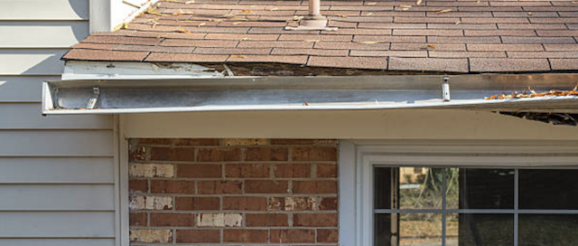7 Signs of Gutter Damage on Your Home

If you’re like a lot of people, your rain gutters are not something you really worry about. They need routine gutter cleaning, but besides that, their functionality is very simple.
It’s not until your rain gutters aren’t doing what they’re supposed to that you understand just how important they are for your home!
WHAT DO GUTTERS DO?
Gutters and downspouts go virtually unnoticed on most roofs in New Brunswick. They fade into the exterior unless the homeowner decided on copper or wood … building materials that are definitely meant to stand out! Most home exteriors are made of durable yet lightweight aluminum or vinyl siding.
The point of gutters is to create a path of least resistance for rain and snow to get off your roof as fast as possible. When they are in good shape, your rain gutters will direct runoff away from the home’s foundation and landscaping, protecting your home’s exterior from mold and mildew, the foundation and basement from leaking water, and the rain gutters themselves from rust.
When they are damaged, it can cause thousands of dollars’ worth of damage to your house and surrounding property.
ARE YOUR GUTTERS DAMAGED?
Gutter damage is too easy to repair to be the reason for any major home repairs! Inspecting your gutters is easy and safe. If you identify any of the following issues, it’s a pretty strong clue that your gutters have some kind of damage.
As soon as you notice a gutter problem, you can decide whether it’s something you feel comfortable fixing or remedying on your own or if it’s a project you should trust a gutter repairman to handle.
Sitting Water Near Your Home
Pooling water near your home is a good sign that your gutters or downspouts are not directing the rain runoff away from your house the way they should be. Standing water can result in mold, weakening of your foundation, and provides the perfect habitat for pesky mosquitoes. And, it will leave the areas around your home constantly soggy and muddy.
Mold or Mildew
Mold or mildew is a bad sign, whether you see mold or mildew on the rain gutters or on the sides of your house. Mold and mildew indicate that there is a lot of moisture in that area – a potential problem with the gutters could be to blame. Remember that mildew and mold are likely to appear on the north side of a home anyway, so if that’s where these substances are appearing, it may be because that area doesn’t get a lot of direct sunlight. This is a scenario where the advice and expertise of a gutter specialist in New Brunswick would be a great help.
Rain Pouring Over the Gutter
You will have to wait until it’s actually raining to look for this type of gutter problem. Hopefully this doesn’t mean that you have gutter damage. It might just be that the gutter is clogged with debris and should be cleaned out. Either way, you want to have it checked right away.
Basement Leaks
Depending on the construction of your home’s basement, your leak might be due to any number of things. The pooling problem we mentioned earlier could definitely cause a basement leak. Egress windows and cinder block walls will only block out so much water. That’s why it is so important to keep your gutters in working order!
Landscaping or Lawn Damage
Gutters pour directly onto the ground most of the time, and landscaping should be laid out to work with this water flow to help it submerge into the ground. However, a gutter leak or clogged gutter will allow rainfall to overflow or pool in areas where it isn’t supposed to. This standing water can kill plants by force or by overwatering. It can also displace flower bed materials like rock or mulch.
Water Marks
Water marks are the first sign that there is too much moisture on a surface. Water marks are sometimes left behind even if pooling water has evaporated or dissipated into the ground. You usually see water marks right beneath the rain gutters or directly behind the downspouts. This is a typically a sign that water is streaming down the outside of the gutters and not staying inside of them.
Visible Gutter Damage
The final sign of gutter damage is the easiest to find. If your gutters are bent, sagging or cracked, they have damage. Following a storm, it’s a good idea to walk around your home to assess any possible damage to the roof, outer walls, and rain gutters. These inspections are in addition to any routine home inspections.
HOW TO PROTECT YOUR GUTTERS?
Here are a few simple tips Select Gutter Service recommends to help prevent gutter damage:
Clean your gutters out at least once each year. You can lengthen the amount of time between gutter repairs by keeping them cleaned out regularly. As with anything else, the better you maintain your rain gutters, the fewer problems you’ll have with them.
The best time to clean out gutters is during the spring, but to be extra cautious, give them a good cleaning in the fall, too. Most homeowners choose to clean their gutters themselves, but there are many local gutter cleaning companies that offer this service so you don’t have to deal with the mess or the risk.
Check your gutters often. Signs of damage can often be visible from the outside of the gutters. A quick inspection – with both feet firmly on the ground – will reveal any of the issues we discussed above.
We’d suggest that you complete an exterior home inspection at the end of each season to ensure that your gutters are functioning properly.
When you see signs of gutter damage, act fast. Fixing an issue before it becomes too bad can save you time and money. A small crack, for example, can be sealed, or the section of gutter with the crack can be replaced very affordably.
However, if you let the issue go on for too long, you might end up needing repairs in your basement, replacing expensive vinyl siding or redoing an entire area of landscaping.
